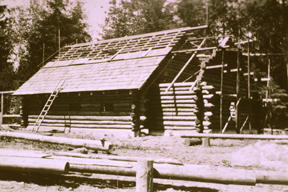There may be some life left in the old logs after all.
Saying a committee that recommended demolition of the Camp Yeomalt scout cabin “lost sight of the historical value of the building,” park board commissioners agreed Thursday to take another look at preservation.
In the interim, steps will be taken to prevent further deterioration of the Depression-era structure.
“It’s going to become sawdust with no action,” said Dane Spencer, park board chair.
The cabin at the three-acre Camp Yeomalt, east of Winslow, was built around 1937 as a federal Works Progress Administration project. It was a Coast Artillery Corps post during the war years, and served for decades as a youth scout cabin.
In recent years it has fallen into disrepair; with a sagging roof and separation between the building and its rock chimney, the cabin is no longer safe for occupancy, park officials say.
In May, the park board endorsed a general plan to replace the cabin with a new but “modern rustic-styled” building, at a cost of $500,000.
That plan would retain the historic cabin’s rock fireplace as the new building’s centerpiece, and could see wood milled from the old logs used for aesthetic treatments.
With no capital funds available, construction was not likely in the foreseeable future.
But the board’s endorsement of the plan prompted historian Jerry Elfendahl and others to meet with park officials to urge rehabilitation of the old cabin instead.
They contend that the building could be restored – from a new foundation to custom-hewn shakes for the roof – for far less than the $300,000 suggested by a recent architect’s study.
“There’s not a lot of exotic materials in the building,” said Mike Brundige, a contractor experienced in building restoration.
“It depends on what you want it for – a cabin with a rope across the door that you peer into, or something you can use as part of the park system.”
Among the suggestions is digging out and lowering the floor, effectively raising the ceiling height above the 6-feet-4 clearance now defined by the aging rafters.
Elfendahl expressed dismay that the cabin has been allowed to molder, even after the park district commissioned a study in 1988 to show steps for preservation.
“Inevitably, the most effective conservation of buildings and landscape must be a continual, ongoing process,” said the study by Jones and Jones Architects, a Seattle firm that also did this year’s study showing replacement alternatives.
Park officials agreed Thursday to put a new tarp over parts of the leaky cabin to prevent further water damage. The question of its long-term future was sent back to a citzizen committee for further discussion, and to get better cost estimates for restoration.
Park board members will tour the site at 5:30 p.m. July 29.
Preservation has its proponents on the board. Commissioner Dave Shorett, who has spent part of his summer traveling the states, observed that “the most loved buildings in the country are those old national park buildings.”
For Elfendahl, the question of preservation extends beyond the Yeomalt cabin to the more than two dozen log structures around the island, most of them built between 1910 and 1940.
“They offer a unique experience of a life and architectural style indigenous to our forested areas,” he wrote recently.
Elfendahl wants to see a full inventory of local log structures on public and private lands, and an education program to help owners with their maintenance and preservation.
He also urged park officials to clean up the Yeomalt cabin and let the public back inside.
“If it’s going to sit there with an abatement sign on it, nobody’s going to be able to go in it and see if it’s worth saving,” he said.



